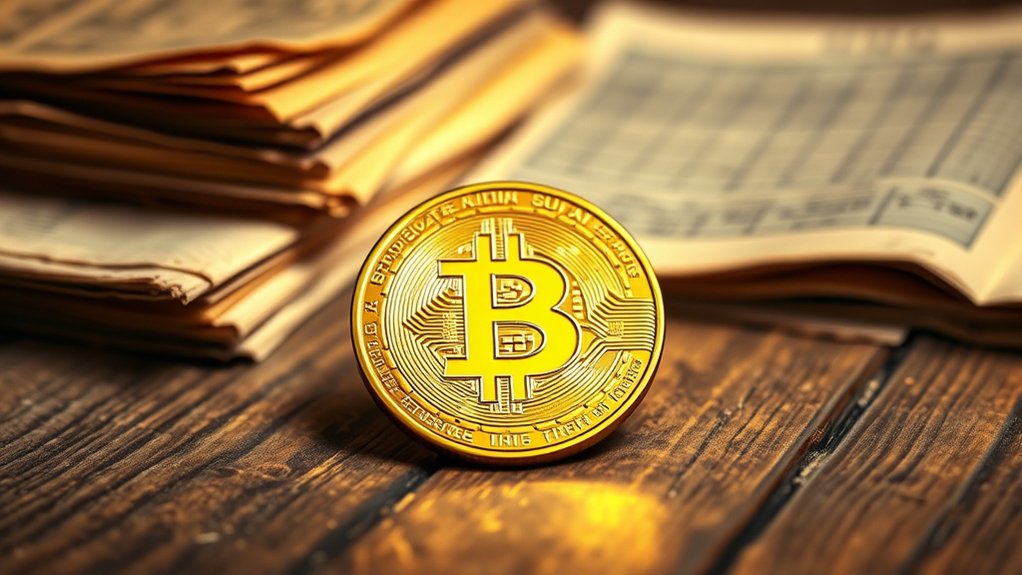Bitcoin was born in the chaos of the 2008 financial crisis. Satoshi Nakamoto dropped the white paper like a bombshell, introducing a decentralized currency. No more middlemen. In January 2009, the Bitcoin network launched, with a genesis block that sneered at traditional banks. It brought the idea of limited supply, combating inflation so common in fiat currencies. Skepticism was rampant, but it’s now a symbol of financial freedom. Curious about the revolution it sparked? Keep on exploring.

When the financial crisis hit in 2008, a mysterious figure named Satoshi Nakamoto decided enough was enough. Tired of watching banks crumble and economies falter, Satoshi published a white paper titled *Bitcoin: A Peer-to-Peer Electronic Cash System* in October 2008. It was a bold move. The world needed something new, something different. By August of that year, the domain bitcoin.org was registered, setting the stage for a digital revolution.
Fast forward to January 3, 2009, when the Bitcoin network took its first breath. The genesis block was mined, featuring a cheeky reference to banking instability. It was a statement—a big middle finger to the traditional financial system. Initially, miners were rewarded with 50 new Bitcoins for their efforts, a number that would halve every four years. Talk about a ticking clock!
The Bitcoin network burst onto the scene, flipping off traditional banks with its rebellious genesis block and rewarding miners in a ticking countdown.
Bitcoin wasn’t just another currency; it was a decentralized design meant to operate without a central authority, which was a revolutionary concept in the context of the cryptocurrency landscape. It utilized blockchain technology, a fancy term for securely recording transactions without needing a bank to hold your hand. The proof of work (PoW) mechanism came into play, rewarding miners for validating transactions. Who knew math could be so lucrative? In fact, the proof-of-work scheme was originally proposed by Adam Back in 1997 as a way to combat spam. Bitcoin operates on a public blockchain, which records all transactions in a secure and transparent manner.
Many didn’t see it coming, but Bitcoin’s limited supply of 21 million coins was a stroke of genius. It was a plan to prevent inflation, unlike those pesky fiat currencies that seem to print money like it’s going out of style. By January 9, 2009, the first open-source Bitcoin client was released, opening the floodgates for developers and enthusiasts alike.
As time rolled on, Bitcoin became the heavyweight champion of cryptocurrencies, influencing countless others. It allowed for peer-to-peer transactions, giving users more control over their funds.
Sure, it faced regulatory challenges, and its value fluctuated like an emotional rollercoaster, but that’s part of the charm. Bitcoin was more than just digital cash; it was a statement about freedom and innovation. And it all started with one person saying, “Enough is enough.”
Frequently Asked Questions
Who Created Bitcoin and What Was Their Motivation?
Bitcoin was created by a mysterious figure, or maybe a group, known as Satoshi Nakamoto. The motivation? A big middle finger to traditional banks and centralized financial chaos, especially after the 2008 crisis.
They wanted a decentralized, trustless system where privacy reigned supreme. Sounds revolutionary, right? With a sprinkle of cryptographic genius, Bitcoin was born.
Now, it’s a global sensation, changing the way people think about money—whether they like it or not.
What Technology Underpins the Functionality of Bitcoin?
Bitcoin runs on a fancy tech called blockchain.
It’s a decentralized digital ledger, which sounds all sci-fi but is really just a way to record transactions without a middleman. Think of it as a public diary—everyone can see it, but you can’t change what’s written.
Security? It’s wrapped in cryptography, so good luck hacking that. Plus, it’s backed by a bunch of nodes verifying everything.
No single boss here. Welcome to the future, folks!
How Is Bitcoin Different From Traditional Currencies?
Bitcoin is like the rebellious teenager of currency. It doesn’t need mom and dad (aka banks) to survive.
Traditional currencies? They’re all about regulation and stability, but Bitcoin thrives on chaos and market forces.
Want to send money across the globe? Bitcoin’s your speedy, low-cost buddy, while banks take their sweet time, racking up fees.
Plus, there’s no central authority controlling Bitcoin. So, if you like freedom, Bitcoin is your go-to.
What Challenges Has Bitcoin Faced Since Its Inception?
Since its debut, Bitcoin has faced a rollercoaster ride of challenges.
Security? Quantum computing might just end it all.
Scalability? Good luck processing transactions without those pesky fees rising.
And let’s not forget mining centralization, where only a few control the whole game.
Then there’s constant volatility and regulatory confusion.
Public trust? Non-existent.
Environmental concerns? They’re not going away.
In short, Bitcoin’s got a lot on its plate—good luck digesting that!
How Can I Safely Store My Bitcoin Assets?
Storing Bitcoin safely? It’s a bit like hiding candy from a toddler.
Hardware wallets are top-tier; they keep your keys offline. Web wallets? Risky business. Trusting third parties? No thanks.
Mobile and desktop wallets are convenient but expose you to hackers.
Paper wallets are cool, but don’t spill coffee on them! Always back up in multiple spots.
Treat your seed phrase like a secret recipe. Guard it, or lose your digital fortune. Simple.





